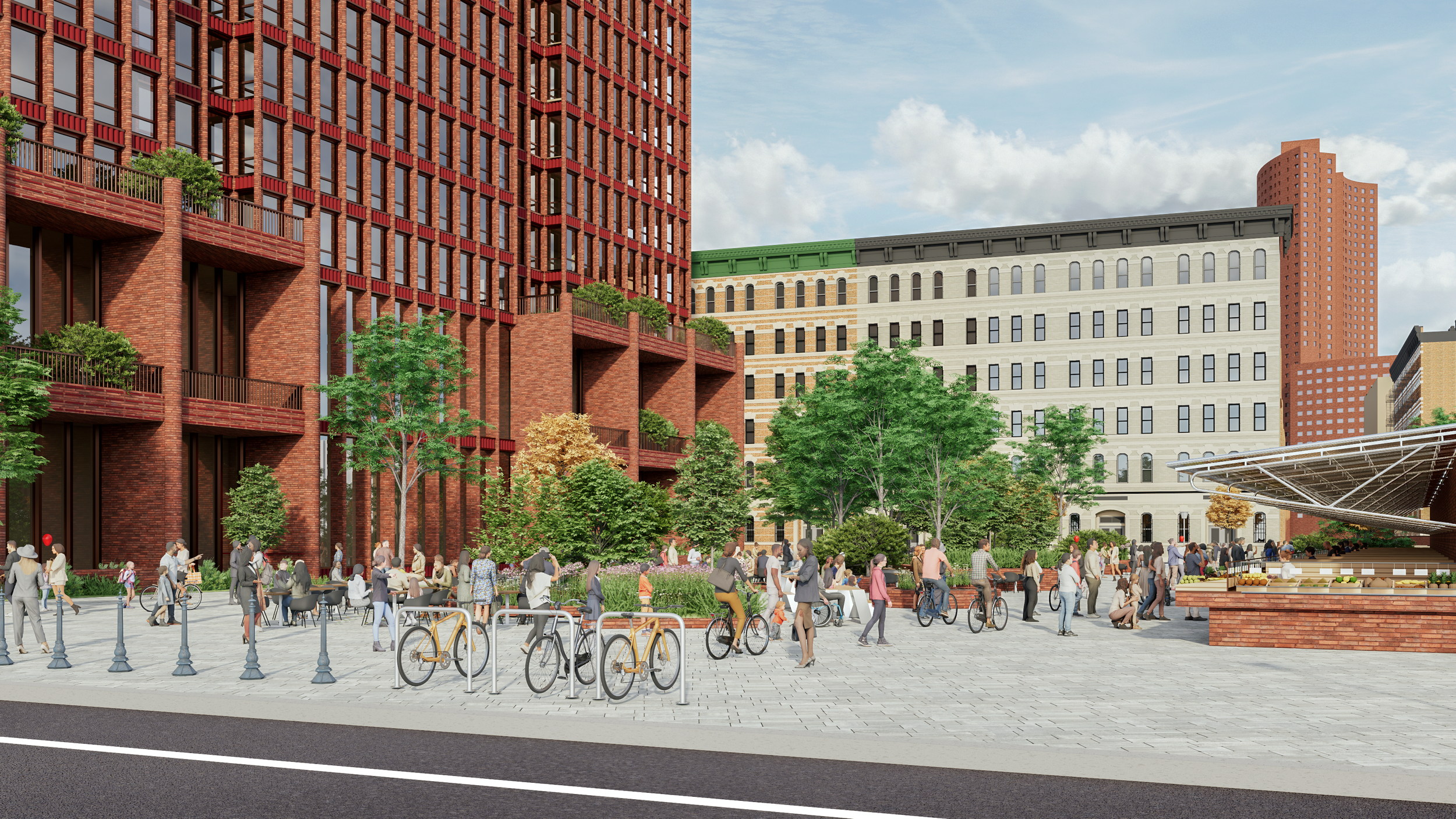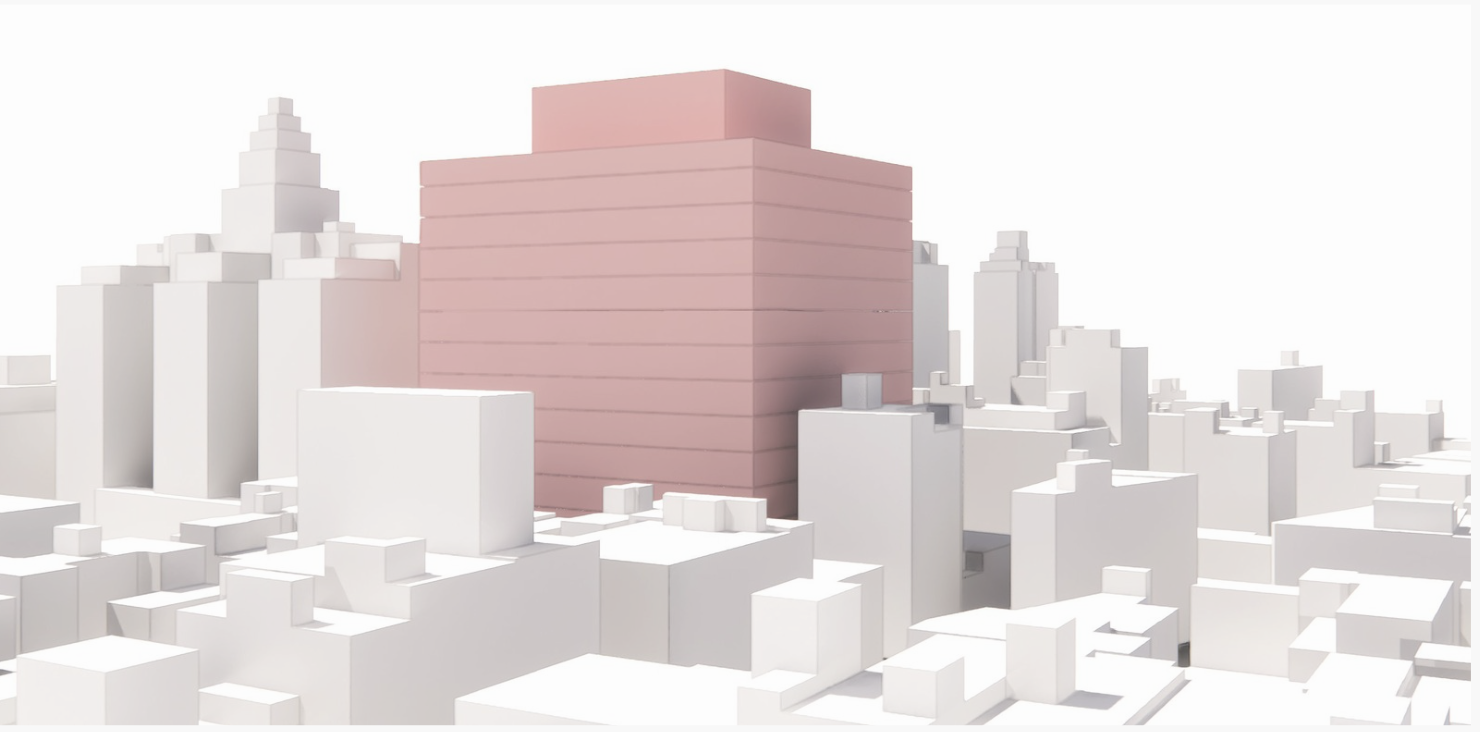An Alternative Plan to Close Rikers Faster and Provide Community-Based Affordable Housing
Conceptual renderings created by Ideas of Order
Since 2021, Welcome to Chinatown has been at the forefront of the fight against the Manhattan Borough-Based Jail—widely known as the “Megajail.”
While we support meaningful criminal justice reform, we believe it must not come at the cost of displacing the Chinatown community or deepening systemic inequities. Our advocacy has focused on advancing a true alternative that meets the goals of criminal justice reform more safely, more quickly, and more fiscally responsibly, while also promoting the long-term resilience of Chinatown.
Explore below to learn more about the harms of the Manhattan Borough Based Jail plan and our efforts to create a more just and sustainable future for our neighborhood
Introducing the Alternative Plan
Over the past several years, Welcome to Chinatown and key partners, including Neighbors United Below Canal and Ideas of Order, have worked closely with urban planners, architects, legal experts, and community stakeholders to develop a viable and community-centered alternative to the Manhattan Borough-Based Jail. This plan was shaped by technical expertise and grassroots input, grounded in the belief that public safety, justice reform, and neighborhood stability are not mutually exclusive. What follows are the six core goals of our proposed alternative.
-
125 White Street, the current site of the Manhattan Borough Based Jail, is the most challenging of the four Borough Based Jails due to the scale, access, soil, and health of the community. The Manhattan Borough Based Jail’s latest budget is an astounding $3.8B, nearly 2x the original budget. It’s estimated completion time is 2032— 5 years behind the City’s mandated 2027 closure of Rikers.
To close Rikers faster and mitigate harm to the Chinatown community, we propose finding an alternative site.
The Federal Metropolitan Correctional Center (MCC) has been unoccupied since 2021 and is a viable alternative site.
• Adaptively reusing the MCC would save time and money, allowing the City to meet its goals without harming Chinatown.
• Relocating the jail avoids the risk from White Street’s high water table, protecting the surrounding buildings and subway tunnel.
• MCC’s location on Park Row streamlines detainee transport, reducing gridlock and leveraging an existing Sally Port.
-
Our plan focuses on reducing the detainee population by redirecting individuals with mental health conditions to underutilized psychiatric beds on Randall’s Island. An estimated half of the 7,000 detainees have mental health issues and would be better served in treatment facilities rather than jail.
Efforts to expand psychiatric bed capacity are already underway, including Manhattan Borough President Mark Levine’s proposal to repurpose vacant beds on Randall’s Island as a more appropriate alternative to incarceration.
-
Chinatown needs new affordable housing.
The real median gross rent in Lower East Side/Chinatown increased by 20.4% from 2006- 2022. In contrast, the median household income only increased 3%. Today, 24.1% of renter households in the community are severely rent burdened, spending more than 50% of income on rent. The Chinatown Core, which includes the jail site, is among the lowest income areas in all of NYC.
-
Accessible public and green spaces are vital for communities of color, lower income households, and the elderly. Chinatown residents have below-average access to parks and green space, with 25 SQF per resident. New York City on average has 146 SQF green space per capita.
-
The loss of White Street Plaza is a detriment for the community. The Plaza was a concession to the community for permitting the 1983 Manhattan Detention Center after years of negotiation. Intended as a car-free civic space, the plaza was commandeered for a parking lot by the Department of Corrections.
Relocating the jail to an alternative site and creating an active streetscape through affordable housing would provide a much needed opportunity for local businesses and residents to thrive.
-
The proposed jail at 125 White Street sits on a complex site that requires extensive dewatering and foundation work—driving up construction costs and increasing the risk of long-term delays. These challenges have already contributed to major cost overruns. Relocating to a site with fewer logistical and geological barriers would significantly reduce construction complexity and avoid wasting public dollars on unnecessary infrastructure hurdles.
As of April 2025, the Manhattan Borough Based Jail at 125 White Street is expected to be completed in 2032, five years behind schedule, and cost $3.8B— nearly 2x the original budget.
Join us in demanding a better plan— faster, safer, and more just.
Chinatown’s future depends on this.
Conceptual renderings created by Ideas of Order
Why the Manhattan Borough Based Jail won’t work
About the Borough Based Jails
In Spring 2017, the City launched the Borough-Based Jail (BBJ) program as part of a broader initiative to reform the jail system. In October 2019, the BBJ plan was officially approved, committing to the closure of Rikers Island by the end of 2026 and the construction of four new jails at a projected cost of $8.7 billion. However, just one year later in 2020, the timeline for the BBJ program was revised, pushing the mandated closure of Rikers to 2027.
Jails will be built in Brooklyn, the Bronx, Queens, and Manhattan. Below are the updated constructions costs ($4.9B or 156% above the initial budget) and timeline of the four jails:
Brooklyn: 2029, $3.0B
Bronx: 2031, $2.9B
Queens: 2031, $3.9B
Manhattan: 2023, $3.8B.
Digital rendering of the Manhattan jail site at 125 White St by Ideas of Order.
The Chinatown Jail Site Is Uniquely Complex and Unstable
View our presentation outlining the environmental, structural, and community harms of building the Manhattan Borough-Based Jail at 125 White Street.
We will continue to advocate
The Manhattan borough-based jail site is currently located on 125 White Street, which was the previous location of the Manhattan Detention Complex (constructed in 1983). The complex was recently demolished over a 12-month period to make room for the new jail, causing higher air and noise pollution levels and decreased foot traffic to the small businesses in the surrounding area.
With a projected construction cost of $3.8 billion and planned height of nearly 300 feet tall, the Manhattan jail will be one of the most expensive buildings constructed in NYC, and one of the tallest jails in the world.
The location, scale, and scope of the Manhattan borough-based jail project have already caused, and will continue to cause, serious harm to the Chinatown community. Ongoing demolition and construction threaten the structural integrity of nearby older buildings, many of which are historically significant and are not built to withstand such disruption.
Disturbingly, residents have already been exposed to prolonged air and noise pollution, along with increased traffic congestion, all of which pose public health risks and accelerate displacement. These impacts are even more harmful given Chinatown’s unique cultural and socioeconomic vulnerabilities. After battling the impacts of 9/11, Hurricane Sandy, the Covid-19 Pandemic, and rising gentrification, Chinatown is extremely vulnerable to the harms that will come with building a skyscraper jail.
We will always pushed for a community-first alternative approach that centers the residents of Chinatown. The community surrounding the jail site is composed largely of working class residents, seniors, and the institutions that serve them. Building a jail within this uniquely vulnerable population would be catastrophic.
As the community faces severe displacement pressures, the White Street plot should be used to stabilize families, not expand incarceration infrastructure. Developing affordable housing in Chinatown’s core strengthens the local economy by keeping residents and businesses rooted in the neighborhood. A stable and diverse residential base increases foot traffic for small businesses, fosters generational entrepreneurship, and ensures Chinatown remains a thriving economic and cultural hub for generations to come.









